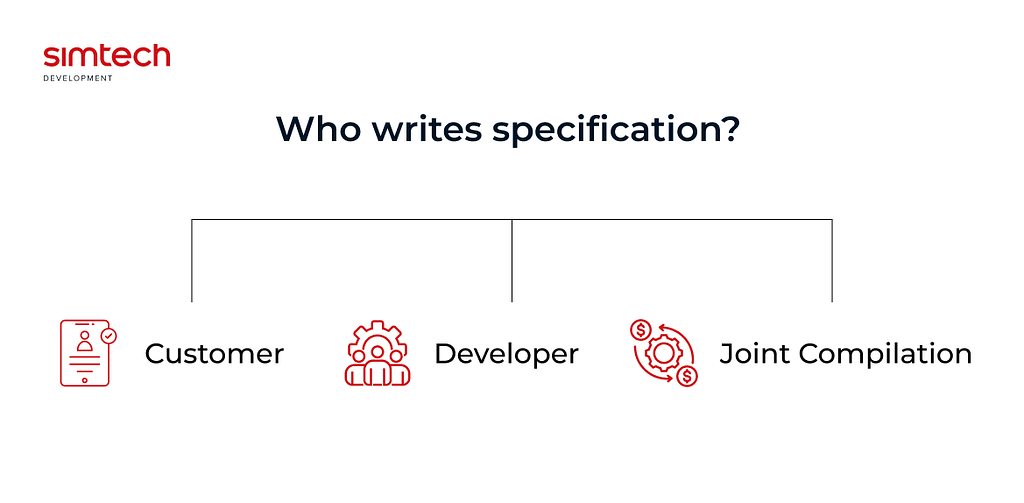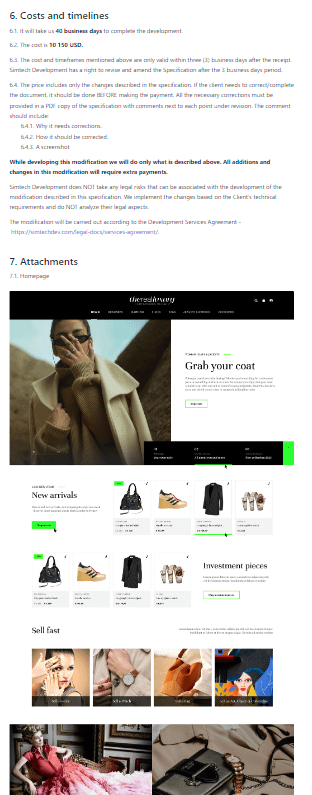The development process involves multiple stakeholders like entrepreneurs, customers, developers and other decision-makers having their own specific requirements. Thus, developing an online shop is a multi-tiered process that needs to be planned in advance. This article covers the topic of making a software requirement specification.
Why use an SRS?
A software requirements specification (SRS) is the ground on which the whole project stands. It outlines the basic principles that the development team will comply with, especially when working by the Fixed Price engagement model. SRS is used as a reference guide to multiple teams — development, quality assurance, operations, and maintenance. That is how everyone involved in the project is kept on the same page.
SRS is like a test paper: it reveals what must be done. If something is not written in it, it is out of the scope of the final deliverables and is subject to another specification or one more revision.
Preparing an SRS can also reduce the time and cost of development because everybody in the team understands what to do and what is the right stage for it.
What’s the difference between SRS, SyRS, and TA
The SRS serves as a blueprint for the development team, providing a clear understanding of what needs to be built and how the software should function. It typically includes information about the system’s purpose, features, interfaces, constraints, and other relevant details. The SRS is a crucial part of the software development process, as it helps ensure that the final product meets the client’s needs and expectations. It is notable to mention that there may be some overlap in the terminology and content of documents that different companies use to describe the development projects. SRS specifically focuses on software requirements, while SyRS or System Requirements Specification covers the requirements of an entire system. A TA or Technical Assignment typically focuses on the technical aspects of a project or task.
Unlike the SRS which involves preparation according to standards such as IEEE 29148-2011 or Rational Unified Process and significantly complicates the process of producing the final service, some IT companies draw up a custom specification taking into account internal processes and features of ecommerce development.
We usually prepare a custom specification, a document that meets internal standards for software development. This happens because we communicate directly with business owners. They don’t want to be overwhelmed with the technical details and complexities of the classic SRS.
What Does an SRS Include
A Software Requirements Specification typically includes the following components:
- Introduction: This section provides an overview of the software system, its purpose, and its intended audience.
- Functional Requirements: These outline the specific functions and capabilities that the software must perform, often in the form of use cases or user stories.
- Non-Functional Requirements: These specify the constraints and quality attributes of the software, such as performance, security, reliability, and usability.
- User Interface Requirements: This section describes the user interface elements, design, and user interaction aspects of the software.
- System Requirements: These include hardware, software, and network requirements necessary for the software to operate effectively.
- External Interface Requirements: This details how the software will interact with other systems, including APIs, data formats, and communication protocols.
- Legal and Regulatory Requirements: If applicable, this section includes any legal or regulatory constraints that the software must adhere to.
- Appendices: Additional information such as diagrams, mockups, or glossaries may be included in this section to support the requirements outlined in the SRS.
The SRS serves as a comprehensive document that guides the software development process and ensures that all stakeholders have a clear understanding of the software system’s requirements.
Read more:
How to Draw Up Functional and Business Requirements for an eCommerce Website
How to write an SRS Document?
While the SRS document can save your time on development, you should write it properly to benefit from this. To do this, follow these simple rules of effective SRS writing.
1. Build an outline (at least, follow an SRS Template)
A good practice is to apply a template taken from a reliable source (IEEE is a good choice). But you are free to use any template or work it out on your own, as we did.
2. Describe the purpose
Before stating the requirements for your project, you should define why the system is built: what problems it solves and what you expect from it after the product is developed.
3. Describe the product characteristics
Your product is your system or software as a whole or features you want to embed into your software/system. It can be the entire website or an extension to an existing piece of software – an add-on. No matter what it is, your product should be described: defined, equipped with a list of characteristics, expected behavior and so on.
4. Specify the requirements
Add more details to your specific requirements for building your product. This will guide the developers.
Who writes the specification and when
In fact, there is no correct answer to this question. Both the customer and the contractor can draw up a specification. Often, this is a joint work. It all depends on the specific situation and conditions. A common scenario is when the developer asks questions, clarifies details and structures information. The customer states what is required of the product.


Compiled by Customer
In this case, the contractor receives a detailed explanation of what needs to be done and, if the task is clear, indicates the cost and duration of the work. However, often the compiler does not clearly understand from the start what to get as a result. That’s why the specification becomes too broad and ambiguous.
To avoid mistakes, it is better to provide business requirements along with a detailed description. So the developer will understand the relationship between the task and the proposed solution. Perhaps there will be a better and cheaper option for the same task.
Compiled by Developer
The contractor who draws up the specification collects the requirements for the task, determines the purpose of the work and the benefits for the customer. Then, they proceed with an interview, either face-to-face or written, where the parties clarify their concerns and find out the rest of the requirements. Only after these steps, the specification is drawn up and agreed with the customer. This method is based on the trust of the customer to the contractor. Therefore, it is so important to choose a reliable IT agency from the very beginning. Nevertheless, with this approach, the customer also needs to be proactive as he or she only knows the specifics of the business that will need to be taken into account in the work.
Joint compilation
The joint preparation of the specification begins with the request of the customer, who voices the requirements for the contractor regarding the job to be done. The contractor, in turn, suggests a way to improve the project. The parties make changes to the final specification and agree on it. This method, like the previous one, is based on the trust of the parties and the professionalism of the contractor.
How do we make specifications at Simtech Development
In the title part, we indicate the name of the work, the project for which the work is being performed, the date the specification was drawn up, the version of the specification, the technology stack used and its characteristics (for example, the name and version of the platform).
The main part describes the technical details: what will be done and what the project limitations are.
The third section covers how testing will take place, for which systems and browsers the modification is being developed, which domains and platform versions are involved.
The fourth section describes the way of communication with the customer. Time slots and possible channels for communication are indicated here.
The following is a discussion of how work is accepted and handed over. As a rule, this is a demonstration on a test store, followed by transfer to a live site.
In the conclusion, we indicate the terms and cost of the work.
Before customizing a project, you should understand what needs to be done. And there might occur different situations, from an abstract business idea to a clear specification provided by the customer. When the parties do not have a clear understanding of what the final project will look like, we suggest performing architecture design – we analyze business requirements, design sections of the website and describe the functionality in detail. Understanding the client’s business idea is critical for us, as the final product and its development process depend on it.
Alex, Development Team Lead in Simtech Development
SRS Example
Here’s an example of a simplified Software Requirements Specification for a hypothetical online bookstore:
- Introduction
- Overview of the online bookstore system
- Intended audience: customers, administrators, and developers
- Functional Requirements
- User registration and login
- Browsing and searching for books
- Adding books to the shopping cart
- Placing orders and making payments
- Managing user profiles and order history
- Non-Functional Requirements
- Performance: The system should support many concurrent users without significant slowdowns.
- Security: User data and payment information should be encrypted and stored securely.
- Usability: The user interface should be intuitive and accessible for all users.
- User Interface Requirements
- The website should have a clean and user-friendly design, with easy navigation and clear calls to action.
- System Requirements
- The system should be compatible with modern web browsers and mobile devices.
- It should be hosted on a reliable web server with sufficient storage and bandwidth.
- External Interface Requirements
- Integration with a payment gateway for processing transactions.
- APIs for retrieving book information from external databases.
This example provides a basic outline of the requirements for an online bookstore system. We intentionally omitted specific metrics for ease of perception. However, a real SRS should specify the wished outcome (‘many concurrent users’ – How many of them? etc.) A complete SRS would also include more detailed descriptions, use cases, diagrams, and other relevant information to guide the development of the software.


Best practices for writing an SRS document in Software Engineering
When writing a Software Requirements Specification document in software engineering, it’s important to follow best practices to ensure the document effectively captures the requirements of the software system. Here are some best practices for writing an SRS document:
- Involve Stakeholders: Engage with all relevant stakeholders, including clients, end-users, developers, and testers, to gather and validate requirements. This ensures that the SRS reflects the needs and expectations of all parties.
- Use Clear and Concise Language: Write the SRS in clear, unambiguous language to avoid misunderstandings. Use consistent terminology and avoid jargon or technical language that may not be universally understood.
- Define Scope and Objectives: Clearly outline the scope of the software project and its objectives. This helps to establish boundaries and provide context for the requirements.
- Organize Requirements: Structure the requirements in a logical and organized manner, such as grouping them by functional and non-functional categories. Use numbering or other identifiers to make the requirements easy to reference and manage.
- Provide Context and Background Information: Include background information about the business or user needs that drive the requirements. This contextual information helps to explain the rationale behind the requirements.
- Be Specific and Detailed: Ensure that the requirements are specific, detailed, and unambiguous. Use examples, diagrams, and use cases to illustrate the requirements and provide clarity.
- Use Standard Templates and Formats: Adhere to standard templates and formats for SRS documents, such as IEEE 830, to ensure consistency and compatibility with industry best practices.
- Include Traceability: Establish traceability between the requirements and their sources, such as stakeholder needs, business objectives, or regulatory standards. This helps in managing changes and ensuring that all requirements are addressed.
- Review and Validate: Conduct thorough reviews and validations of the SRS with stakeholders to confirm that the requirements accurately represent their needs and expectations.
- Give Document Assumptions and Constraints: Clearly document any assumptions made during the requirements gathering process and the constraints that may impact the implementation of the software.
- Consider Non-Functional Requirements: In addition to functional requirements, ensure that non-functional requirements such as performance, security, usability, and reliability are adequately addressed.
- Maintain Version Control: Establish a version control system for the SRS document to manage changes and updates over the course of the project.
By following these best practices, you can create an SRS document that effectively captures the requirements of the software system and serves as a valuable guide for the development team.
Common Mistakes to Avoid When Writing an SRS Document
When writing an SRS document, it’s important to be aware of common mistakes that can compromise the quality and effectiveness of the document. Here are some common mistakes to avoid when writing an SRS:
- Ambiguity and Lack of Clarity
- Incomplete Requirements
- Over-Engineering, including unnecessary or overly complex requirements
- Lack of Stakeholder Involvement
- Unclear Scope and Objectives
- Poor Organization and Structure
- Inconsistent Terminology
- Lack of Traceability
- Neglecting Non-Functional Requirements
- Failure to Review and Validate
- Ignoring Constraints and Assumptions
- Lack of Version Control
When you don’t need a specification
It often happens that you can do without a specification. Therefore, it is most rational to start with a description of your general vision:
- What should the product do?
- Who will use it and how?
- What to include in the final product and what to exclude?
With this understanding, you turn to the contractor. Perhaps the developer will offer to refuse the specification, and use the agile approach. In this case, we first develop and release a prototype, then collect feedback, constantly supplementing the requirements based on the data collected. This method fits large projects with vague requirements, as it allows you to jointly develop a product that is most suitable for the target audience.
In our company, the agile approach to development is implemented by a dedicated development team. The team works by sprints and reports to the customer at the agreed time.
When is a dedicated team a preferred option?
- If the project is at the idea stage, and the business processes, functionality and final vision have not yet been fully thought out.
- If you want to quickly launch an online store MVP to test your business hypothesis
- If you need support and further development of the functionality of an existing project.
- If you want to be actively involved in the development process, see progress, communicate with the team and check intermediate results.
In such cases, it is better to hire a dedicated development team. This form of cooperation assumes a flexible approach and allows for changes to the project requirements as development progresses.

